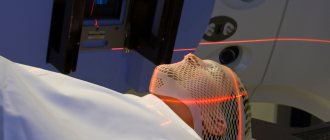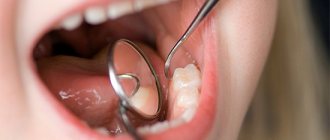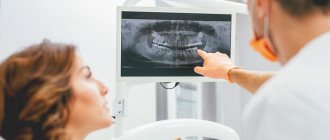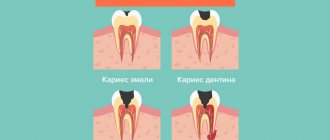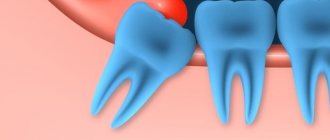Chronic pulpitis is the gradual degeneration and death of the neurovascular bundle located inside the tooth. Acute pulpitis becomes chronic within a period of several days to several weeks; sometimes the disease develops within up to two years and is a consequence of deep caries.
Chronic pulpitis leads to periodontitis and osteomyelitis. The infection quickly spreads to the roots of healthy teeth or causes gum gum inflammation. It is very painful, but the main danger is the spread of infection throughout the body through the bloodstream.
If you have pain or hypersensitivity of your teeth, contact the Mitino Dental Center. Experienced specialists will carry out treatment quickly and painlessly.
Causes of pulp inflammation
The main cause of pulpitis is the penetration of infection into the pulp cavity, in which a bundle of blood vessels and nerves is located.
The causative agents of the disease can be both pathogenic (Staphylococcus aureus) and conditionally pathogenic (lactobacillus) microorganisms. They can penetrate into the tooth in several ways:
- through the dentinal tubules in case of poor oral hygiene, accumulation of bacterial plaque and stone in the gum pockets;
- through cracks in the enamel caused by tooth trauma;
- through cracks due to a fracture of the dental crown;
- through the apical opening of the root canal against the background of periodontitis, osteitis and other chronic inflammatory processes of the oral cavity.
- Inflammation can also occur after treatment of deep caries
What to do in case of exacerbation of chronic pulpitis
Chronic pulpitis is unpleasant because tooth pain can recur in any unfavorable environment. Exacerbation can be caused by:
- stress;
- influenza, ARVI, ENT diseases;
- hypothermia;
- injury, including minor.
Pain during exacerbation of chronic pulpitis affects the jaw and the trigeminal nerve area - temple, chin, cheek.
If your chronic dental disease has worsened or you have a toothache, make an urgent appointment with your dentist. You should not take painkillers in this situation - they can weaken the effect of the anesthetics that the doctor will use during treatment.
Etiology of pulpitis
Based on etiology, which implies the nature of the inflammatory process, pulpitis is divided into three types. The classification is carried out depending on the nature of the irritant acting on the pulp:
- Infectious pulpitis develops in acute, but more often chronic diseases of the teeth and oral cavity (caries, osteomyelitis, periodontitis, etc.). In rare cases, the infection enters the root canal and pulp through the circulatory system from other units of the jaw or internal organs.
- Traumatic pulpitis develops when a tooth is damaged with the opening of a traumatic cavity (crack, chip) into the pulp. Occurs with sports injuries, crown and root fractures.
- Iatrogenic, that is, occurring after dental treatment . Occurs after treatment of deep caries, when the internal tissues of the teeth are irritated by the use of chemical, mechanical or thermal irritants.
Knowledge of the etiology helps the dentist select the most appropriate treatment methods and avoid complications in the future.
Why does chronic pulpitis develop?
The pulp is the soft tissue of the tooth; inside it there is a nerve and blood vessels that feed it. Like any organ, the pulp is characterized by a protective reaction to the invasion of infection - inflammation. In this case, swelling, suppuration and attacks of sharp throbbing pain occur. This is acute pulpitis.
Any infection can lead to inflammation of the pulp. Patients with deep caries, gum disease, sinusitis, osteomyelitis of the jaw, abrasion of teeth, and traumatic exposure of the pulp become ill especially easily.
The infection penetrates the dentin:
- through a crack in the root;
- with blood flow through vessels;
- from a carious cavity.
If the patient postpones going to the dentist, after 1-2 days, collagen fibers are produced in the pulp and the first stage of the disease begins - fibrous pulpitis.
Acute pulpitis can become chronic:
- As a result of the vital activity of pathogenic microorganisms: lactobacilli, staphylococci, streptococci. For example, after suffering from infectious diseases: rubella, influenza, ARVI.
- After a tooth injury: dislocation, fracture, incorrect treatment, or if the patient does not go to the dentist for acute pulpitis.
- When exposed to chemicals and dental materials.
Symptoms
Inflammation of the pulp is not difficult to differentiate already at the stage of examining the oral cavity and interviewing the patient. This disease is characterized by:
- sudden onset of pain and its intensification at night;
- a gradual increase in pain intensity and duration in the first 3-5 days from the onset of the disease;
- irradiation (spread) of pain to the ear, eye, chin, depending on the location of the diseased tooth.
A characteristic feature of pulpitis, which makes it possible to distinguish it from caries and other dental pathologies, is a sporadic increase in pain, which is not associated with thermal, mechanical or other effects on the tooth.
Symptoms of chronic pulpitis
With different forms of the disease, its manifestations may vary. For example, with hypertrophic pulpitis there is almost no pain, but there is bleeding of the tooth root. The reason is the growth of foreign tissue in the tooth.
If inflammation is still accompanied by pain, with chronic pulpitis it has a characteristic feature - a delayed nature. The patient continues to feel pain even after the irritant is removed. Even with relative stabilization of the condition, a feeling of heaviness in the tooth remains.
Symptoms of chronic pulpitis:
- bleeding;
- sensitivity to cold, hot food and other external irritants;
- the tooth aches in attacks, including at night;
- there is an unpleasant taste in the mouth;
- difficulty chewing and biting food;
- bone tissue is sparse in the root zone;
- under the filling you can see a dark carious border;
- tooth enamel has changed color.
Forms and types
The classification of pulp inflammation divides the disease into two forms according to the nature of the development of the pathology:
- Acute pulpitis is a first-time inflammatory process that lasts from 3 to 5 days and is accompanied by intense symptoms.
- Chronic pulpitis is a long-term inflammation that develops in the absence of treatment for acute pulpitis. Symptoms tend to periodically worsen, and in the intervals between them there is no discomfort or it is very mild.
Both forms have several subtypes, which differ in localization, degree of spread, and the nature of the development of the inflammatory process.
Types of acute pulpitis
There are four types of acute pulp inflammation:
- Focal pulpitis . It is diagnosed during primary inflammation, when the carious cavity reaches the pulp. The localization of the pathological focus is the upper part of the tooth. This type of disease is accompanied by the most intense symptoms and signs of inflammation spreading along the trigeminal nerve and nearby lymph nodes.
- Diffuse pulpitis . Diagnosed 1-2 days after the onset of acute inflammation. The lesion is located throughout the coronal part of the tooth, sometimes down to the neck and root part of the pulp. Attacks of pain last relatively short time and worsen when the patient lies down.
- Serous pulpitis . An advanced form of acute pulpitis, accompanied by painful pain symptoms that do not subside.
- Purulent pulpitis . The final stage of acute inflammation, in which a focus of suppuration forms in the pulp. The process is accompanied by signs of acute intoxication of the body, increased pain when eating warm and hot food. Symptoms weaken when cold is applied to the diseased tooth.
Classification of chronic pulpitis
Chronic pulpitis occurs in three types:
- Fibrous inflammation is the most common variant and lasts about 3 months after the initial inflammation. It is accompanied by bleeding of the pulp when touched, periodic pain in the tooth when it comes into contact with cold or hot food.
- Hypertrophic inflammation is a condition accompanied by the formation of a polyp inside the pulp. It looks like a piece of gum growing out of a tooth. Pain with this type of chronic pulpitis is minimal or absent.
- Gangrenous inflammation is the most dangerous pathological process, which is accompanied by active necrosis of tooth tissue. Accompanied by an unpleasant putrid odor from the mouth.
Good to know! In addition to the listed types of acute and chronic pulpitis, dentistry distinguishes deep root, two- and three-channel inflammation, as well as pulpitis under a filling.
Forms of chronic pulpitis
The disease causes severe changes in the structure and function of the tooth. Depending on the stage, it is customary to distinguish the following forms of chronic pulpitis:
Fibrous
In the initial stage, the inflamed cells of the neurovascular bundle degenerate and become thicker. The patient feels constant heaviness and swelling inside the tooth. The vascular bundle begins to respond to changes in ambient temperature with aching pain. This happens when a patient goes outside from a warm room in winter.
At this stage, the disease is reversible; with proper dental treatment, the dental nerve can be restored.
Ulcerative
If the inflammation progresses, ulcerations appear on the pulp crown. This is the result of the proliferation of putrefactive bacteria in the pulp chamber. Dark putrefactive plaque in the recesses of the enamel is noticeable visually. The tooth begins to hurt when pressed, and there is a constant unpleasant taste in the mouth.
Hypertrophic
If, after acute pulpitis, the tissues not only increase in size, but also begin to divide, a polyp forms inside the tooth. The growth has a grayish-pink color and is detected during electroodontodiagnosis.
Due to the characteristics of the growth of dental tissues, this type of pulpitis occurs in patients under 30 years of age.
Concrete
In patients over 45 years of age, calcification salts are deposited in the dentin: denticles, petrificates. Their chemical composition causes irritation and then inflammation in the neurovascular bundle.
The symptoms of concrementous pulpitis are similar to trigeminal neuralgia: pain radiating to the temple and chin, aching pain at night.
Gangrenous
This is the last stage of chronic inflammation of the pulp, at which time the neurovascular bundle is completely destroyed. The tooth is deprived of blood supply and nutrition, darkens, and the putrid smell from the mouth increases.
The apical opening of the root is deformed. Gangrenous pulpitis most often leads to the development of acute periodontitis or the formation of granuloma at the root of the tooth.
Complications
In the absence of adequate treatment, pulp inflammation spreads beyond the boundaries of the root canal, to the periodontium and periosteum. In addition to the formation of a purulent focus (abscess) that opens onto the mucous membranes of the oral cavity next to the affected tooth, there is a possibility of developing more serious complications:
- flux or inflammation of the periosteum, which leads to the loss of a diseased tooth, and sometimes healthy teeth located nearby;
- osteomyelitis or purulent inflammation of the bone, which requires complex, expensive therapy;
- phlegmon - lesions of the soft tissues of the face, their “melting” with purulent exudate.
Each of these complications can, with a certain degree of probability, lead to life-threatening conditions, for example, sepsis.
Pulpitis
Treatment of patients with pulpitis
Treatment of children with pulpitis should be carried out taking into account the fact that foci of chronic infection of odontogenic origin can adversely affect the course of general diseases. In this regard, there is a need to reconsider the issue of indications for the sanitation of temporary teeth with chronic forms of pulpitis.
The question of the advisability of treating a child with chronic pulpitis of a primary tooth should be decided after an X-ray examination and comparison of the clinical and radiological manifestations of the disease.
When visiting the dentist, the biggest fear is the drill. Dental interventions are more likely than others to be associated with pain and other unpleasant sensations. Therefore, the problem of premedication is especially relevant in pediatric dental practice. Psychological and pharmacotherapeutic effects on restless children with heightened emotional reactions relieve excessive stress.
For premedication, minor tranquilizers are prescribed - sibazone and mebicar in an age-specific dosage 30-40 minutes before the start of treatment. For young children, it is preferable to use sibazon, and to achieve a stronger tranquilizing effect, a combination of sibazon with mebikar.
For pulp anesthesia, various methods of anesthesia are used: infiltration, conduction, application, intraligamentary, reflex analgesia, electrical anesthesia, as well as anesthesia: mask, intubation, intravenous.
When treated with vital pulp extirpation, intrapulpal anesthesia is sometimes used using a needle-free injector.
Traditional methods of anesthesia - conduction and infiltration - cause a negative reaction in children in the form of fear of the syringe and needle. In this situation, intraligamentary anesthesia is the most appropriate, which has been increasingly used in dental practice in recent years. There are only isolated studies on the use of this method of pain relief in children. In pediatric dental practice, domestic ointments are used for topical anesthesia: 5% pyromecaine and 5% pyromecaine with methyluracil on collagen.
General anesthesia is performed for children who cannot tolerate the anesthetic, with an unbalanced psycho-emotional state, accompanied by fear, fainting, increased gag reflex, as well as children with epilepsy, cerebral palsy, mental retardation, etc. In pediatric dental practice, mask anesthesia with a mixture of fluorothane, nitrous oxide and oxygen is more often used for general anesthesia. By inhibiting salivation, fluorotane has a great narcotic effect (50 times more active than nitrous oxide), ensuring rapid entry into a state of anesthesia and restoration of consciousness. The use of this method provides highly effective anesthesia of the pulp.
Pulp tissue has a significant ability for reparative and plastic processes. The main task in the treatment of children with pulpitis is to eliminate odontogenic infection and, if possible, preserve the viability of the pulp, especially its root part, as well as the prevention of periodontal diseases.
During treatment, it is very important to provide conditions for the completion of the formation of teeth, temporary and permanent, and the physiological resorption of temporary teeth. Conservative and surgical treatment methods are used. Conservative therapy is aimed at preserving the entire pulp. Surgical treatment consists of partial (pulpotomy or amputation) or complete (pulpectomy or extirpation) removal of the entire pulp. The choice of treatment method is determined by the nature of the inflammatory process, the state of the child’s health, the group affiliation of the tooth, the location of the carious cavity, the degree of root formation or its resorption (for temporary teeth).
- Biological method
Preserving the vitality of the pulp of temporary teeth promotes their function until physiological change, prevents the development of complications in the periodontium and jaw bone, and in permanent teeth ensures the complete completion of formation.
Complete preservation of the pulp in children is possible with acute partial pulpitis, including traumatic origin, and chronic fibrous pulpitis. Some authors indicate the possibility of using a biological method for acute general pulpitis that is not accompanied by a reaction of the surrounding soft tissues, but in most cases in children this recommendation is clinically untenable.
The use of a biological method in the sanitation of teeth with pulpitis helps reduce repeated visits from patients by 10 times and saves the dentist’s work.
A contraindication for this method is active resorption of the roots of primary teeth. This method showed the best results in children at the stage of compensation of the carious process. In children with a decompensated form of caries and low levels of nonspecific resistance of the body, conservative treatment of temporary teeth with pulpitis turned out to be ineffective.
Most doctors are supporters of the radical method of treating patients with pulpitis, since in widespread practice the biological method gives a large number of complications. This is due to errors in diagnosis, lack of clinical tests that accurately determine the form of pulpitis and the extent of the inflammatory process. The discrepancy between clinical and pathological diagnoses is 70-90%.
To preserve the vitality of the pulp, it is indirectly coated with the drug, if the pulp is not opened, and directly, during which a medicinal paste is applied to the exposed pulp. Drugs selected for conservative treatment must meet the following requirements: have a pronounced antibacterial and anti-inflammatory effect, stimulate pulp regeneration and not cause irritation, in addition, they must have no allergic component and microbial resistance to them.
Most clinicians both in our country and abroad, when using the biological method, give preference to drugs based on calcium hydroxide. Therapeutic materials containing calcium hydroxide have antimicrobial activity (due to a pronounced alkaline reaction), stimulate the plastic function of the pulp, resulting in the formation of replacement dentin - a “dentin bridge”. The best results are observed in the case of using “Calmecin” in the treatment of temporary molars in children aged 4 to 7 years, when the roots are in a state of physiological rest, and in permanent immature teeth, especially in the treatment of chronic fibrous pulpitis.
In recent years, the number of negative results of treatment with a biological method using drugs based on calcium hydroxide has increased: the possibility of calcification of the coronal and root pulp cannot be excluded; the destruction of all microorganisms in softened dentin is not ensured.
However, at present, preparations based on calcium hydroxide remain popular. In pediatric dentistry, they use Calmecin, Dycal (Germany), Sterimax, Life (USA), etc. Depending on the indications, biological treatment for pulpitis is carried out either in one or two visits.
When treating in two visits, for the first time drugs with antimicrobial and anti-inflammatory effects are used: antibiotics, glucocorticoids, enzymes. However, neither antibiotics, nor glucocorticoids, nor other antibacterial agents should be left under a permanent filling, so as not to cause inhibition of the dentin-forming function of the pulp and selective suppression of microorganisms.
When treating teeth with immature roots using the biological method, glycosaminoglycan preparations are used - honsurid, luronite. Medicinal pastes containing collagen, bone meal with heparin, and lysozyme with vitamin A are also offered. Zinc-eugenol paste continues to be used, although N.M. Chuprynina believes that this paste rarely gives a positive result.
- Vital amputation method
A viable root pulp serves as a reliable barrier to the penetration of microorganisms into periapical tissues and prevents the development of odontogenic foci of inflammation. Therefore, the vital amputation method is aimed at preserving the vital activity of the root pulp. The apical part of the root pulp, periodontium and growth zone represent a single biological whole. The root pulp is well supplied with blood, the tissue of the growth zone contains a large number of cellular elements with high protective and shape-forming abilities. The root pulp is built like deep-fibrous connective tissue with a small number of cellular elements and is capable of metaplasia and the construction of dentin-, cement- and osteo-like tissue. These features of the root pulp contribute to its resistance, especially in the apical part, to adverse influences.
The indications for using the vital amputation method are the same as the biological method: acute partial and chronic fibrous pulpitis. Incomplete root formation and just begun resorption of the roots of primary teeth serve as direct indications for the use of the vital amputation method. When the crown of a permanent immature tooth is broken with the pulp exposed over a significant extent, vital amputation of the pulp is indicated if no more than 2-3 days have passed since the injury. With significant resorption of the roots of primary teeth, the reactivity of the pulp is reduced, and the method of vital amputation is contraindicated. Opening of the tooth cavity and removal of the coronal pulp is carried out after infiltration or conduction anesthesia. For children with unbalanced psycho-emotional perception, local anesthesia can be combined with psychotherapeutic and medicinal preparation with small tranquilizers in an age-appropriate dosage.
Having opened the tooth cavity, the pulp is removed from the crown and canal mouths and deep amputation is performed to 1/2 or 1/3 of the length of the root, depending on the form of pulpitis, and in case of pulp injury, on the period that has passed since the injury. During pulp removal, it is necessary to avoid the formation of a laceration. To stop bleeding, hemostatic agents are applied to the wound surface for 10-20 minutes. The wound surface of the root pulp is covered with the same medicinal pastes that are used in the conservative method of treating patients with pulpitis. The paste is applied carefully, without pressure. After vital amputation, in teeth with unformed roots, the root continues to grow in length, and a dentinal bridge is formed in the area of the wound surface.
In case of significant infection of the pulp in single-rooted permanent teeth, a method of preserving the apical part of the root pulp and the growth zone is indicated. To do this, the maximum possible removal of the pulp with a boron is carried out under anesthesia, and a mixture of phenol and formaldehyde (in a ratio of 2:1) is applied to the stump for the purpose of mummification and disinfection. Treatment is completed by applying formaldehyde paste to the stump. The paste is prepared extempore: 1 drop of formalin, 1 drop of glycerin, a crystal of thymol and zinc oxide. This creates a layer of mummified pulp, which is separated from the viable apical part and its growth zone. The effectiveness of treatment is monitored after 3-12 months and until the end of root formation. If it is determined that root formation has stopped, treatment is carried out as for chronic periodontitis, i.e. complete removal of the pulp.
- Vital extirpation method
The method can be performed in temporary and permanent teeth with complete root formation, if the root canals are passable. If these conditions are met, the method is applicable for all forms of pulpitis and is carried out in the same way as in adults.
When performing this method, it is necessary to ensure good anesthesia. However, in pediatric dentistry, the vital extirpation method is not widely used, since it is time-consuming and labor-intensive, and children are not always able to withstand long-term multi-stage treatment.
- Devital amputation method
Most often in pediatric dental practice, this method is used for acute general and chronic fibrous pulpitis in temporary molars, as well as in permanent immature molars. Devital amputation is not indicated for chronic gangrenous and aggravated chronic pulpitis. If the tooth cavity is not opened after removing the softened dentin, then it is advisable to open it with a spherical bur No. 1, having previously applied application anesthesia.
Arsenic paste is used as a devitalizing agent, which has a necrotizing effect on the pulp. The use of arsenic paste is due to its ability to quickly diffuse into the tissue. If the arsenic paste remains in the tooth cavity for more than 24-48 hours, arsenic anhydride reaches the periodontium and causes foci of destruction in it.
Necrotization of the pulp with arsenic paste still remains the main method of treating children with pulpitis, since this method makes it possible to spare the child’s psyche as much as possible and to carry out the treatment painlessly on the second visit. In this case, there is no need for local anesthesia, which children are so afraid of. Arsenic paste is used in the same doses as in adults. During the second visit, the coronal pulp is removed, carefully opening the tooth cavity and taking into account the topography of the root canal orifices. A tampon with a resorcinol-formalin mixture (liquid) is left in the tooth cavity, which has the ability to diffuse along the dentinal tubules, and after mummification of the pulp, fill the space between the reduced root pulp and the canal walls. On the third visit, in conditions of a dry mouth, a temporary bandage and tampon are removed, and resorcinol-formalin paste is applied to the bottom of the tooth cavity, which, due to diffusion, completes the mummification of the pulp.
Mummifying substances do not disrupt the process of root formation and resorption of the roots of temporary teeth.
With a low-pain pulp, during the period of active resorption of the roots of temporary teeth, phenol-formalin can be used as a necrotizing agent (the tampon is left for 4-5 days). Since arsenic paste is highly toxic, it is proposed to use pastes containing paraformaldehyde to necrotize the pulp. It causes vasodilation in the pulp, followed by stasis and necrosis, but does not lead to pathological changes in the periodontium, even after prolonged exposure. Treatment is carried out using the amputation method in three visits. Paraformaldehyde paste in a volume equal to the head of a spherical bur No. 3 is applied for 5-6 days. There are ready-made para-formaldehyde pastes: “Sinarsen”, “Fasipulpin”, “Devipulp”, etc.
However, when prepared for future use, they quickly lose their activity. This is due to the fact that paraformaldehyde depolymerizes in air under the influence of water and temperature.
If acute pulpitis in children is accompanied by a pronounced inflammatory reaction of the periodontium and surrounding soft tissues, lymphadenitis, then arsenic paste should not be applied on the first visit. You should carefully open the tooth cavity, create an outflow of exudate and prescribe anti-inflammatory treatment: orally - acetylsalicylic acid (the dose depends on age) after meals; sulfonamide drugs, calcium gluconate, drinking plenty of fluids. The application of arsenic paste is carried out after the inflammatory phenomena have subsided.
- Devital extirpation method
The method is indicated for all types of pulpitis in single-rooted temporary and permanent teeth and permanent formed molars with well-passable canals. The stages of treatment for devital extirpation are the same as for adults.
The method of complete pulp removal is the most reliable in terms of eliminating odontogenic infection and preventing periodontitis, if the pulp is completely removed and the canals are sealed throughout. However, the tops of the roots of temporary teeth are often curved due to the permanent tooth germ located underneath them, and it is not always possible to completely fill them. In this case, resorcinol-formalin paste, which has a mummifying effect, should be used for filling.
For well-passable canals, non-irritating oil-based pastes (eugenol, sea buckthorn oil, etc.) are used for filling.
Errors in treatment and diagnosis are associated with insufficient history taking, incorrect assessment of the signs and extent of pulp inflammation, and underestimation of pain symptoms. They can also arise when there is insufficient justification of the indications and contraindications for the treatment of teeth with biological pulpitis and the method of vital amputation of the coronal pulp, underestimation of the unique course of acute general pulpitis and the reaction of the surrounding soft tissues in young children. A lot of troubles are associated with arsenic paste. If the temporary dressing is not applied tightly, then the arsenic paste that leaks into the surrounding tissue can cause necrosis of the mucous membrane of the gums, cheeks, and tongue. With prolonged contact with tissue, necrosis and sequestration of part of the alveoli are possible. Due to an overdose or prolonged stay of arsenic mouth in a carious cavity, acute arsenic periodontitis develops. In children, the diffusion of arsenic paste into the periodontium occurs faster than in adults, due to the anatomical features of temporary teeth. Acute periodontitis that occurs has a long course and is difficult to treat. For treatment, use the arsenic antidote unithiol, as well as a solution of iodinol and potassium iodide.
A common mistake in treating patients with pulpitis in primary molars is perforation of the bottom of the tooth cavity, when the anatomical features of the structure of hard tissues and pulp of temporary teeth are not taken into account.
In recent years, many criticisms have been leveled at the popular method of treating temporary and permanent immature teeth with pulpitis—devital pulp amputation. Indeed, often due to a diagnostic error in chronic gangrenous pulpitis with significant pulp necrosis, treatment of temporary molars is carried out using the method of devital amputation. Often, the opening of the cavity of a temporary molar is not performed completely, but “somehow.” In order to reduce visits, treatment is carried out not in three, but in two visits. As a result of these medical errors, the necrotic pulp in the root canals does not have time to sufficiently mummify under the influence of impregnation agents, and chronic granulating periodontitis gradually, painlessly develops.
Forecast
Untimely and improper treatment of children with acute and chronic pulpitis can lead to a rapid transition of the odontogenic inflammatory process to the next stage: periodontitis, purulent periostitis, acute osteomyelitis.
Treatment
To treat pulpitis, exclusively surgical methods are used - vital or devital removal of the pulp followed by filling the cavity. During vital removal, the doctor injects an anesthetic and removes the inflamed pulp tissue with a bur or mechanically. During devital removal, the pulp is first exposed to special drugs that kill the neurovascular bundle.
Important! Treatment of a tooth with pulpitis with arsenic is an outdated method that is used extremely rarely.
After careful mechanical treatment of part or all of the pulp, the doctor performs a filling in several stages: first, he isolates the root canals, then places a photopolymer filling in the tooth crown. If a significant part of the crown is destroyed, there is intense purulent and necrotic processes, the doctor may remove the tooth.
Treatment of chronic fibrous pulpitis
Having assessed the overall picture of the disease, the dentist determines exactly how treatment will be carried out. There can be two of them:
- Biological (also called conservative). During this method, the dentist does everything possible to keep the pulp alive. Unfortunately, when it comes to a disease such as chronic fibrous pulpitis, this method is rarely used.
- Surgical. Used quite often. It consists in the fact that the pulp is completely removed and the tooth is filled. This can be done in one visit or two. In the latter case, to anesthetize the dental nerve, a special paste, for example, based on arsenic, is first placed in the tooth, and only during the next visit is the pulp removed. In this case, first remove its upper part, then the remains from the dental canals. After which they are processed and sealed.
With a timely visit to the dental clinic and proper treatment, it is possible not only to get rid of pain and associated discomfort, but also to save the tooth.
Professional oral hygiene, regular visits to the doctor and timely treatment of dental diseases can avoid the manifestation of this disease.
Pulpitis of baby teeth
Pulpitis of baby teeth is dangerous because the pathological process from the affected tooth can move to the rudiments of permanent units. If the inflammation has not become irreversible, biological treatment is carried out. This gentle technique involves suppressing infection and the inflammatory process with maximum organ preservation of the pulp and neurovascular bundle.
Good to know! In case of pulpitis of primary teeth, it is extremely undesirable to remove the nerve from the tooth and fill the root canals, since this part of the teeth is not yet formed.
After using antiseptics and anti-inflammatory drugs, preparations with calcium hydroxide and calcium hydroxyapatite are placed into the pulp. These products will stimulate the formation of secondary dentin within a week. Only after this the doctor will place a permanent filling.
Clinical researches
Clinical studies have shown that for the effective treatment of chronic localized periodontal disease of traumatic etiology in young patients, a complex of treatment and preventive measures is required, which includes products for individual oral hygiene in the form of treatment and preventive toothpaste "ASEPTA PARODONTAL SENSITIVE" (JSC "VERTEX" , Russia) and mouth rinses "ASEPTA PARODONTAL ACTIVE" and "ASEPTA PARODONTAL FRESH", (JSC "VERTEX", Russia), which allows, within 6 months after completion of complex treatment, not only to improve oral hygiene and 55.37 % reduce inflammatory processes in the gums, but also reduce the number of relapses of localized periodontitis by 21.36%.
Sources:
- Prevention of recurrence of localized periodontitis in young A.K. YORDANISHVILI, Doctor of Medical Sciences, Professor, North-Western State Medical University named after. I.I. Mechnikov, Military Medical Academy named after. CM. Kirov, International Academy of Sciences of Ecology, Human Safety and Nature.
- Clinical studies of antisensitive toothpaste “Asepta Sensitive” (A.A. Leontyev, O.V. Kalinina, S.B. Ulitovsky) A.A. LEONTIEV, dentist O.V. KALININA, dentist S.B. ULITOVSKY, Doctor of Medical Sciences, Prof. Department of Therapeutic Dentistry, St. Petersburg State Medical University named after. acad. I.P. Pavlova
- Report on clinical trials to determine/confirm the preventive properties of commercially produced personal oral hygiene products: mouth rinse "ASEPTA PARODONTAL" - Solution for irrigator." Doctor of Medical Sciences Professor, Honored Doctor of the Russian Federation, Head. Department of Preventive Dentistry S.B. Ulitovsky, doctor-researcher A.A. Leontiev First St. Petersburg State Medical University named after academician I.P. Pavlova, Department of Preventive Dentistry.


